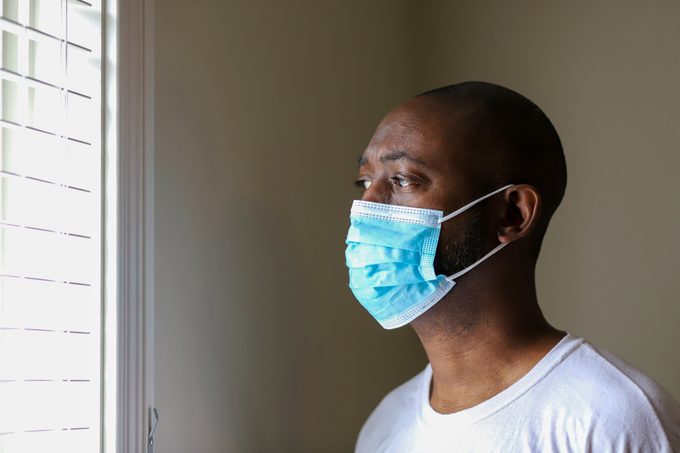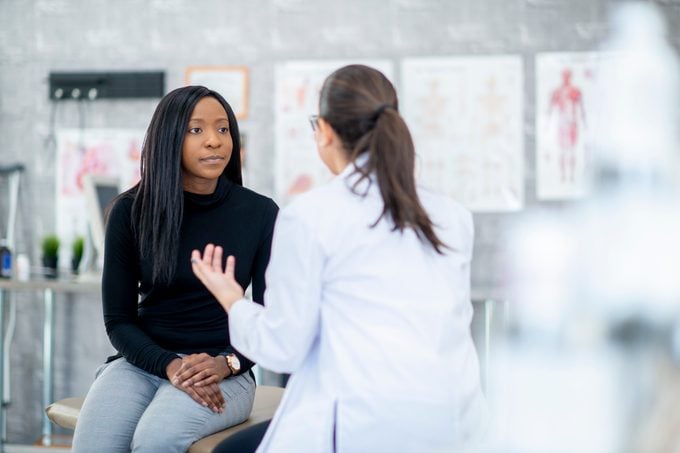Covid-19 Hits People of Color Harder—How Racism Plays a Role
Updated: Jun. 01, 2021
Covid-19 is having a greater impact on people of color. Here's how one extended family struggled to get care during the Covid-19 pandemic.
The numbers are clear: The coronavirus pandemic hits people of color harder. Black and Hispanic people are more likely to get Covid-19, need to be hospitalized for it, and are far more likely to die from it than white or Asian people, according to data from the Centers for Disease Control and Prevention. But why?
Economic and social differences play a part in explaining the racial disparity during this public health emergency, says Ashwin Vasan, MD, PhD, a general practitioner, professor of public health at Columbia University, board adviser of Inseparable and president of Fountain House, two non-profits dedicated to increasing access to mental health services in black and brown communities.
People of color are more likely to live in multigenerational households and densely populated areas, and make up a higher percentage of incarcerated populations, all of which are situations that increase transmission of the virus. Black and brown people are also more likely to have conditions like diabetes, obesity, and heart disease, which have been shown to increase the risk and severity of the illness. And they are more likely to be poor or have jobs with inadequate benefits, which limits their access to insurance and healthcare—and ability to take time off—when they do get sick. This is what one doctor is doing to save his black patients with diabetes.
While it may not be overt, what all of these factors add up to is an insidious type of racism in healthcare, Dr. Vasan says. This issue is every bit as important as police violence to the well-being of people of color, he adds.
“As people from across the country unite in an effort to dismantle the systems that have oppressed the black community for far too long, we need to identify which specific systems are broken and how they can be fixed,” he says. “Healthcare for people of color is one vital area that must be addressed in this great reckoning.”
Getting a Covid-19 test is more difficult
Good treatment starts with an accurate diagnosis, and you can’t get diagnosed without a test. While Covid-19 test problems have been widely reported throughout the country, minorities and immigrants are having an even harder time getting tested, says Siobhan Davenport, president of Crittenton Services of Greater Washington, a non-profit program that helps at-risk teen girls and their families.
“Ninety-four percent of the community we serve are black and brown, and our families often report to us difficulties in their experience with the healthcare system,” she says. “During this time, many people have told us they are having difficulty getting a Covid-19 test, even after a person in their household tested positive.”
The Santiago family shows just how complex this issue is. “I didn’t have any symptoms at the beginning. My first sign that I might be sick was when I lost my sense of taste,” says Maria, 36, a phlebotomist and mother of two in Montgomery County, Maryland. At that time, in early April 2020, that wasn’t a well-known symptom of Covid-19 but she still had good reason to think she might have become infected. Her brother, sister-in-law, mother, and son all had the illness—at least they thought they did. Even though they were all sick only some were able to get a test.
On April 16, 2020, Maria got tested through the doctor’s office where she works, allowing her to circumvent the long line for county tests. Two days later it came back positive.
Her brother, Alvaro, 22, had a much different experience. “My brother works in a nursing home, a very high-risk job, but he was denied a test multiple times,” she says. While it’s true that tests were scarce at that time, Alvaro Santiago was an essential worker in a nursing home who knew he’d been exposed; he should have been at the top of the list to get tested. The county health department didn’t give an official reason but told him to continue working and quarantine himself if he felt sick.
While some people of color have been flat-out denied a test, the discrimination usually happens through more understated ways, says Davenport, who has been working with the Santiago family. For instance, black and brown people are less likely to have health insurance and more likely to have language barriers, she says, both of which were issues for Alvaro and may have contributed to his not being able to get tested.

Treating Covid-19 at home is a privilege many people of color don’t have
After Maria received her positive diagnosis, she was told to go home, quarantine, and not to come back to work until she’d tested negative for 14 days. Once home, the illness set in and she felt very sick, with body aches and a fever. Her 20-month-old son, Dylan, also became ill. She called her doctor, who told her there was no treatment so they should simply drink hot tea and stay home. She followed the doctor’s orders but it was well over a month before she could return to work. She was able to manage such a long time off only because she had help from her husband and daughter, who never showed symptoms.
Staying at home, whether to quarantine or to recover, is often more complicated for people of color. Sixty-three percent of Americans who live in poverty are Native American, black or Hispanic, according to Poverty USA. People of color are more likely to work “essential” jobs where they are paid hourly and don’t have benefits like time off, Davenport adds. They may also feel pressure from their employers to continue working even if they don’t feel good. These factors can make black and brown people reluctant to seek a diagnosis and resist staying home to recover as the financial toll would be too great or they fear losing their job.
Medical treatment for Covid-19 is harder to get
Maria, Dylan, and Alvaro Santiago recovered on their own eventually but their mother, Elida, 63, was a different story. “She was very, very sick. She couldn’t get out of bed for a week,” Maria says. “We got her some medicine but it didn’t help. We knew she was at high risk because of her diabetes. We were crying and crying. We were really scared she was going to die.” The doctor said to keep her home but her condition got so bad that they took her to the hospital.
“You could see there were two lines into the hospital, one for people with insurance and one for people without,” Maria says. Elida did not have health insurance—just like 11 percent of black people, 19 percent of Hispanic people, and 22 percent of Native Americans, according to the Kaiser Family Foundation. She was not admitted and did not receive medical treatment.
While Maria says she doesn’t personally feel like she was treated differently because of her race, she does admit it is a problem in her community. Dr. Vasan says it’s common for people of color to have their symptoms minimized or to not be believed. They’re also less likely to receive adequate treatment and pain management, he adds.
Fortunately Elida recovered on her own but she is still very weak and may never be the same, Maria says. Many people of color are not so lucky. Black people are more than twice as likely, and Hispanic people 1.5 times more likely, to die of Covid-19 than white people, according to the CDC.
Less access to healthcare overall
People of color often lack access to preventive health services and have many more barriers to getting healthcare when they do get sick, Dr. Vasan says. “Healthcare access is lower in communities of color, as they are more likely than white Americans to not have health insurance, so are less likely to be connected to long-term primary care and mental health care, and thus more likely to rely on emergency rooms as their main source of care, which is lower quality especially for chronic issues like mental health,” he says. “Also, they are more likely to live in areas that have fewer healthcare facilities and healthcare workers, making care harder to access.”
This has become even more complicated during the coronavirus pandemic as people have been limited from going out, even as more are getting sick.
Another issue is cultural insensitivity on the part of healthcare institutions, including a lack of religious and language accommodations, which can be especially difficult for immigrants, Davenport says. Maria emigrated here from El Salvador 13 years ago but says she still sometimes has difficulty navigating the complicated healthcare system.
“It’s not uncommon to have young children acting as translators for their parents in complicated medical conversations,” Davenport says.

A lack of trust in the healthcare system
“All of these things taken together lead to a deep, but well-earned, mistrust of the healthcare system by many communities of color, which can result in delaying care or not seeking care at all,” Dr. Vasan says. This mistrust has broad implications for communities during the coronavirus pandemic where getting testing and care early are essential to containing the virus.
Solving this issue and getting people of color the healthcare they need isn’t an easy fix; systemic problems need a systemic fix. The first step should be establishing universal health coverage, Dr. Vasan says. “No one should have to choose between paying the rent or paying their healthcare bill,” he says.
Addressing needs on a community level is essential to building trust. “We need to combine improvements in healthcare access and quality with investment in social issues,” he says. “Things like housing, education, jobs, and public safety are health issues; they play a big part in physical and mental health.”
America also needs to invest in alternatives to systems that focus primarily on punishment and control. “Right now the jail and prison system is the largest provider of mental healthcare in the country, and 60 percent of incarcerated people are people of color,” he says.
(Here’s how one person tuned into a BIPOC mental health podcast to help navigate through the pandemic.)
Where we go from here
For many people with Covid-19, simply surviving the illness doesn’t mean you’re finished with it. It remains to be seen how long-lasting the health effects will be but there is some evidence that patients could be affected for years to come or even the rest of their lives. Then there is concern for people who have not been infected yet. It’s clear the coronavirus is going to be affecting individuals and communities long after the pandemic is declared over.
“Overall this was a very scary experience. I felt like my hands were tied because no one cared, unless we were dying no one would help us,” Maria says. “I’m still worried about my mom’s health and I’m scared for my daughter because she has asthma. What do I do now?”
Ultimately it’s up to us to insist that basic healthcare is a human right. Everyone, regardless of race, should be engaging in community and legislative advocacy to ensure black and brown needs are represented by their elected officials, Dr. Vasan says. In the meantime, we need to work together to set up better procedures and protocols to ensure that everyone has access to Covid-19 tests and treatment.













